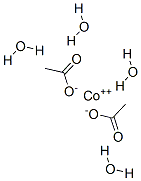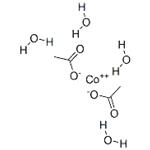Reddish violet deliequecent crystals.
- Cobalt(II) acetate tetrahydrate is used to prepare complexes for examination of the properties of metals with unusual coordination geometries.
- used as a catalyst for oxidation and esterification.
- used as an industrial catalyst to harden paints and varnishes, an active catalyst for oxidation and esterification reactions.
Cobalt(II) acetate tetrahydrate is used as an industrial catalyst to harden paints and varnishes, an active catalyst for oxidation and esterification reactions. It is also used to prepare metal complexes having unusual coordination geometry.
Cobalt(II) acetate tetrahydrate may be used in the preparation of [Co3(OH)2(H2O)2(aptet)4] (aptet = 4-aminophenyltetrazolate) and new tetradentate cobalt(II)-Schiff base complex.
Cobalt(II) acetate tetrahydrate may be used in the synthesis of the following:
- cobalt nanoparticles.
- cobalt(II)–aminophenyltetrazolate coordination polymer.
- tricobalt complexes with mixed μ-acetato and μ-pyrazolato ligands.
Cobalt(II) acetate tetrahydrate has an octahedral structure, the central cobalt orbit is coordinated by four water molecules and two acetate ligands. Cobalt(II) acetate tetrahydrate becomes anhydrous by 140oC.
reagent type: catalyst
core: cobalt
Moderately toxic by
ingestion. Questionable carcinogen. A skin
and eye irritant. Human mutation data
reported. See also COBUT
COMPOUNDS. When heated to
decomposition it emits acrid smoke and
irritating fumes.
Several recrystallisations from 50% aqueous acetic acid give the tetrahydrate. It is converted to the anhydrous salt by drying at 80o/1mm for 60hours. [Beilstein 2 IV 120.]



